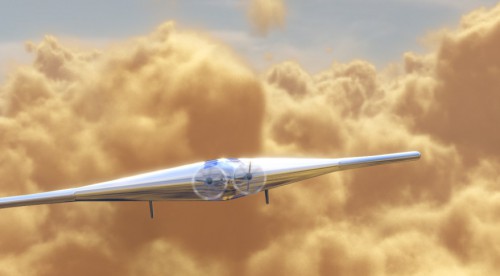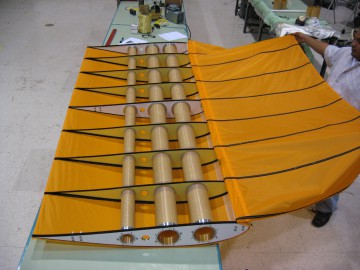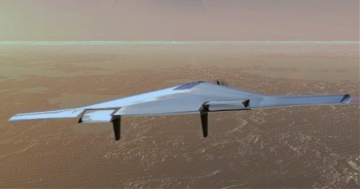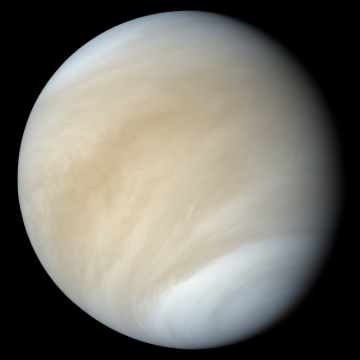
With so much attention now on the rovers and spacecraft at Mars, Saturn, Ceres, comet 67P/Churyumov-Gerasimenko, and, soon, Pluto, it may seem like Earth’s closest planetary neighbor Venus has been forgotten again. But no, Venus is still very much on the minds of researchers who are busy developing a concept airplane which could cruise for years in the hellish planet’s atmosphere.
The aircraft design, called the Venus Atmospheric Maneuverable Platform (VAMP), is being developed by Northrop Grumman as an entry in NASA’s next New Frontiers planetary science competition. It will compete for $1 billion in NASA funding, possibly as early as Oct. 1, 2015. The winning mission will need to be ready for launch by 2021, according to Jim Green, NASA’s director of planetary science. VAMP will have to compete against other high-priority New Frontiers destinations such as the lunar poles, Jupiter’s moon Io, Saturn, and trojan asteroids. It is also part of Northrop Grumman’s 2015 Challenge: Lighter Than Air Competition (for the High School Innovation Challenge):

“Northrop Grumman is currently performing research on an unmanned concept vehicle called the Venus Atmospheric Maneuverable Platform (VAMP). VAMP is a very large, but incredibly light inflatable aircraft that integrates Northrop Grumman’s diverse capabilities in deployables, unmanned aircraft, semi-buoyant vehicles, and space exploration into a unique planetary exploration vehicle. Using a combination of powered flight and passive floating, VAMP will be capable of staying aloft for long periods of time collecting vital data about Venus and its atmosphere. After reaching Venus’ orbit aboard a carrier spacecraft, VAMP will deploy and inflate with a buoyant gas. With a wingspan of approximately 150 feet and 100 pounds of payload carrying capability, VAMP will be able to cruise through the Venus skies at altitudes between 31 and 43 miles (55 and 70 kilometers) for several months to a year.”
This year’s challenge uses the VAMP program as inspiration to design and build an airship with agile maneuverability, speed, endurance, and payload-carrying capability.
VAMP will also need to clear some engineering hurdles before that can happen. Nothing like it has ever flown before, on Earth or elsewhere. The closest thing is a pair of ultra-light wings built in 2008 and 2010 by Northrop’s partner L.Garde Inc. of Tustin, Calif., for a defunct Defense Advanced Research Projects Agency initiative called Rapid Eye, which were meant to be collapsible, rocket-deployed drones which could arrive for reconnaissance duties anywhere on Earth an hour after launch. The project was cancelled in 2010. While the wings for Rapid Eye were only 2 meters long, the wings for VAMP would need to be much larger, at 55 meters across.
Right now, the technology is rated a three on NASA’s Technology Readiness Level (TRL) scale, a “proof of concept” level. Once “flight proven,” those technologies are rated at TRL 9. According to Ron Polidan, Northrop’s Redondo, California-based chief architect of civil systems, “The one nice thing for New Frontiers is they would like you to be at TRL 6 by the preliminary design review, so that gives you a few more years.”
“We have a list of a about a dozen instruments that people have proposed we fly… and we convened a science advisory board to help us define both the instruments and where the aircraft needs to be to take the needed measurements,” Polidan said.

VAMP would fly autonomously, carrying a variety of scientific instruments to study the Venusian environment; there is still a lot about Venus which scientists don’t understand. While the surface of Venus is extremely hot and inhospitable, higher altitudes are more benign, making the aircraft concept feasible. An airplane could fly the (mostly) friendly skies of Venus with little problem.
“Surviving on the surface for any longer than four hours and getting high-resolution data is a challenge,” said Constantine Tsang, a research scientist at the Southwest Research Institute in Boulder, Colo. She is also a member of Northrop’s all-volunteer VAMP science advisory board.
“Not a whole lot different than flying on Earth,” Polidan said. “If you wanna just sprinkle sulfuric acid all over yourself, that would be more like what you have on Venus.”
The acidity at altitude, unlike the unforgiving surface conditions, “we can handle now with a lot of the materials we have,” Tsang added.
A big question is: How much science VAMP could do, being an airborne craft instead of a surface lander or rover? The answer is not everything scientists might want, but still a lot.

“VAMP could not answer all key questions,” said Robert Herrick, a University of Alaska-based surface specialist. “Primarily, the platform would be for atmospheric science.” Herrick chaired the committee in charge of the NASA-chartered Venus Exploration Analysis Group’s (VEXAG) 2014 science roadmap. Or as VEXAG member Kevin McGouldrick, a research scientist with the Laboratory for Atmospheric and Space Physics at the University of Colorado, Boulder, noted, VAMP could answer all of the big atmospheric questions, half the questions about surface-atmosphere interactions, and perhaps some of the Venusian surface questions by “remotely sensing the surface.”
According to Tsang, VAMP could remotely study the surface using nadir-facing infrared sensors.
“That would tell you whether the surface is basaltic, has igneous rocks, things like that,” Tsang said. “But you couldn’t do isotopic ratio measurements of minerals, for example, that rovers could be doing.”
Having a functioning lander in Venus’ brutal surface conditions is difficult enough, never mind a rover. That may be a while in the future yet. The airplane concept would seem to be a good way to study both Venus’ atmosphere and surface, at least for the near future. Venus is thought to have been more Earth-like earlier in its history. VAMP could help answer the question of how it became such an inhospitable place since then.
The design concept might also be well-suited to explore other places in the Solar System such as Saturn’s moon Titan, and similar ideas are also now being proposed. A Titan airplane would provide unprecedented views of Titan’s methane seas, lakes, and rivers, as well as study what clues the moon might offer in terms of astrobiology. Scientists consider Titan to be similar in many ways to the early Earth, when life was just starting to gain a foothold.
If it wins the competition, VAMP could provide a unique opportunity to study our nearest planetary neighbor up close in a way not possible before, and help scientists understand why “Earth’s twin gone bad” changed the way that it did over time.
Want to keep up-to-date with all things space? Be sure to “Like” AmericaSpace on Facebook and follow us on Twitter: @AmericaSpace




No tax dollars for this please. Titan…yes, Venus…no. Please. I just don’t see the point. Venus is hell.
fascinating, thanks for report.
I work near LASP on related technologies, I can’t believe this slipped by me.
I’d be interested in working on “drop sondes” for this mission.
An airplane is not required, nor a billion in funding. A blimp would do it.
While we can argue about whether an airplane concept is better than a blimp or a lander or some other concepts, more focus on the study of Venus is long overdue. Considering that Venus is a near-twin of Earth in terms of size, composition and position in the solar system yet evolved into a very different and hostile planet compared to the Earth makes it a prime target for comparative planetology. Despite uninformed claims to the contrary by those outside the science community, the study of Venus actually has much to offer in deepening our understanding of the limits of planetary habitability in general and the processes that affect Earth’s long term habitability in particular. Considering that there might be more Venus-like planets in our galaxy (on the order of 100 billion, according to one estimate) than more Earth-like planets, the study of Venus becomes even more significant.
http://www.drewexmachina.com/2014/09/15/abundance-of-venus-analogs/
Andrew,
Interesting points.
Comparative data from Venus, could be very helpful in evaluating how the earth’s climate works.
The study of the climates of Venus, Mars, and other worlds has already had a profound influence on scientists’ understanding of our climate for over a half a century now. And the continued study of these worlds (and now extrasolar planets) will provide deeper insights into how our climate works and why. The continued study of the climates of Mars and Venus (the latter of which has taken a back seat in recent years) is more important more than ever and isn’t something that can really wait, given the issues we face today.
Perhaps some future proposal could combine the best of Esposito’s SAGE (SAGE Lite?) with something like VAMP.
What a pity that the Russian space industry and academics are in such disarray and relations at a low ebb.
Yes, unfortunately 30 years after the last of the highly successful Venera/VEGA flights to Venus, all of the hard-won experience the Russians require for mounting such missions is now gone.
The recent cloud city click-bait associated with Venus research was disgusting. NASA allowing their brand on warp drives and such PR trash is shameless.
The NASA budget is becoming more and more in the news now that SLS is progressing and the NewSpace mob screams bloody murder trying to counter the cheering for it that is growing by the day. Unfortunately the funding for robotic science exploration probes and Earth science is getting dragged into the fray also. Being a proponent of Human Space Flight – Beyond Earth Orbit and supporting a Moon return as the new agency “Horizon Goal”, I don’t like these stories distracting the public from what is in my view the immediate issue: an ideological battle being fought between NewSpace and “Old Space” for the future of space exploration.
The pure science value of Venus and other future probes in my view should be at this critical juncture in the history of spaceflight be advertised at a later date.